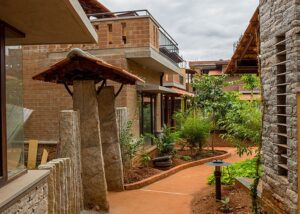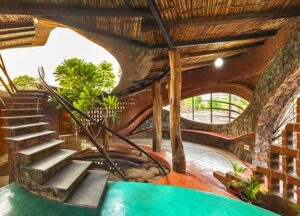By Kritika Juneja
Change is always provocative in the beginning but with the changing problems, their solutions also need to change simultaneously. Every era during past has developed its own style of architecture affecting people’s lifestyle as well as the culture of that particular place. Traditional architecture was the result of concentration of people in a location as the population was very unevenly distributed and was concentrated more in areas where water was available. Today technology has simplified many a thing for us including the construction techniques, the high strength material technology giving us the flexibility to design but sometimes in the surge to follow our culture we start imitating it. Especially in this part of the sub-continent, where a 1000 years old culture is backing us, we need to understand that imitating a piece of architecture is not going to solve the problems of the modern India. Modern India require modern solutions by keeping the fragrance of tradition alive.
Attaining Sustainability (Source: – www.iaacblog.com)
On the other hand, it is totally wrong if we start following westernization of architectural style blindly and equate it with modernisation. It reminds me of a well said phase by Prof. S.M. Akhtar “Architecture can never be imitated”. Every site has its own context and we need to respect that. Cultural heritage is an irreplaceable part of a city but no city can be conserved in its development- irrespective of how valuable the city fabric is, new functions and therefore new architecture will appear. What we need to preserve is the taste of culture within us and our modern architecture- it should never be lost.
Sustainability as an approach to holistic building design
Architecture is like a creation of a new organism with which I remember a beautiful phase
“A building is not a mass of brick and concrete, but is a living organism which breathes”. Ultimately such architecture is holistic and is the need of the hour. Various terms have been coined from time to time like organic architecture, green architecture, eco-sensitive architecture which are no different from each other and by following the holistic principals we can achieve the goal of designing a sustainable environment. When the earth was formed, it was a virgin, untouched in all its glory but since the advent of Homo sapiens, its naturalness kept on getting disturbed. The man poked the earth, hit it, abused it in return of air, water and food given by the nature to us. How long could the earth sustain vulnerability to its “natural surroundings”. Its ecological balance got disturbed and it hit us back with its fury in terms of global warming, landslides etc.
Green Construction in India (Source: – ecoideaz.com)
Creating a balance between the open and built(adelto.co.uk)
We as humans, the built environment we have created and the organic life around us, are all the part of a larger world where our every action has a direct or an indirect impact on the whole ecosystem. By following the holistic principals while designing we can provide a healing environment to our user which in turn not only affects the physical, emotional, mental but also spiritual state of the human body.
In today’s context sustainability has a very wrong definition but sustainability is a problem-solving process for a building and its impact in isolation as well as on the surroundings. Sustainability can be achieved by managing the building starting right from its construction to its maintenance till its disposal. There is a very wrong perception of sustainability which is practiced today, that by placing solar panels or having a few sustainability measures our building becomes sustainable as sustainability is a very wide term. But no, it is a process or indeed a holistic approach towards design which deals with each and every aspect of the building.
Being in the close proximity with nature is what is needed by a human at the most and traditional buildings complied with the same hence, resulting in holistic architecture. Today we are lost somewhere in the crowd of so-called urbanism irrespective of the context the site offers.
Spirituality as an approach towards a holistic building design
Spiritual approach in design of buildings can be achieved by enriching the lives of the people who are going to use our building. A design is always a process in which architects are not only responsible for providing the basic functions a building needs to offer but also make it an entity to remember. This can be achieved by following the holistic principals and wiliness to meet the unmet change in the society. Innovation never comes by compromising the basic necessities but by creating a masterpiece incorporating all the necessities in a way that it allows the user to directly interact with the nature and allow them to feel as a small part of it. Many of the master architects have achieved this through their efforts. By discovering and formulating our higher self, we can become more innovative, empathetic and will unleash the creative potential within us. Once we are able to understand ourselves and our abilities it will be much easier to channelize our energy. As an architect it is our basic responsibility to identify and react to the dream of our client and creating something innovative.
Curvaceous Brick House
At last, to sum it up by saying that Nature is life and life is nature, we as humans who itself are a small creation of nature always feel homely around the nature and if our built environment responds positively to nature, we would feel comfortable. This so-called surge of globalisation to become modern is leading us nowhere and as a result we are heading towards a robotic future. Thus, we require an immediate change by inculcating nature as a part of us. Holistic design approach is nothing but a way of living. The way in which we rise above the basic necessities and think about something beyond it. It can be what we call as sustainability, eco-friendliness or the various similar terms which we have coined from time to time as the worldwide ecological imbalance is the outcome of our own actions.
About the Author
 Kritika Juneja, Architect, Former Architecture Journalist and pr, Creative Group, New Delhi, Former editorial intern Architecture Journalism and Criticism Organisation
Kritika Juneja, Architect, Former Architecture Journalist and pr, Creative Group, New Delhi, Former editorial intern Architecture Journalism and Criticism Organisation






